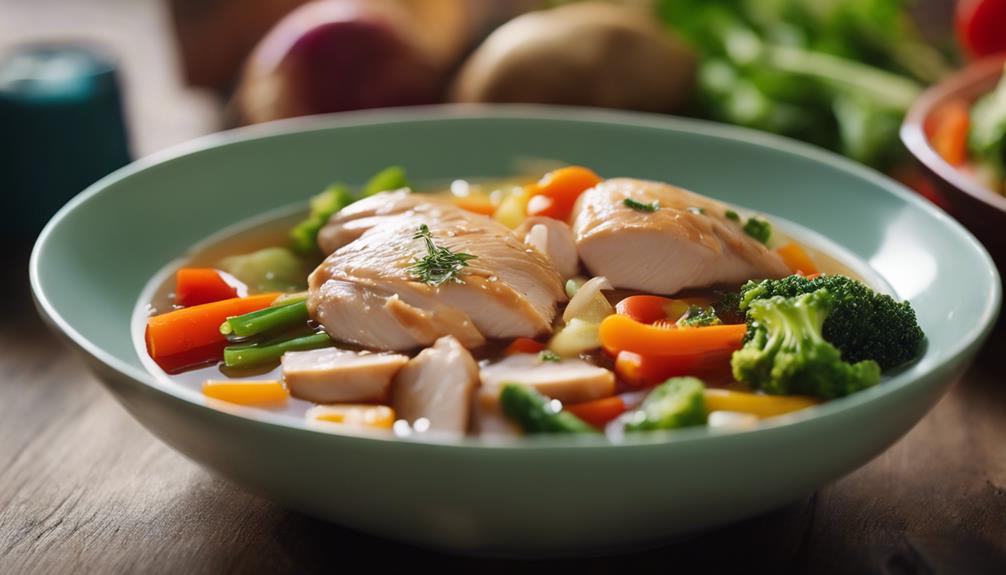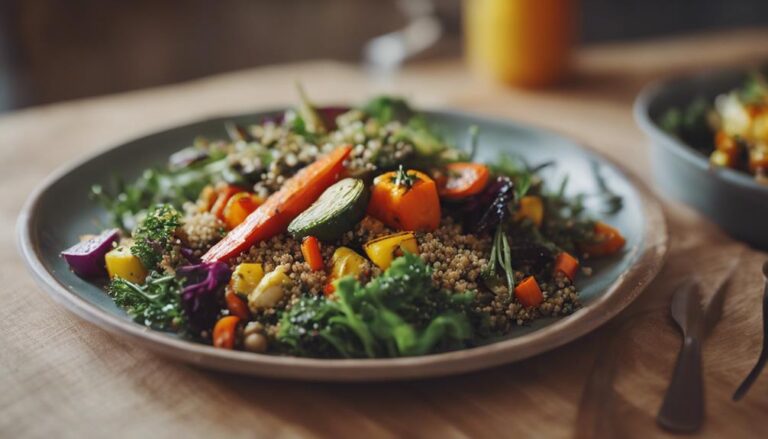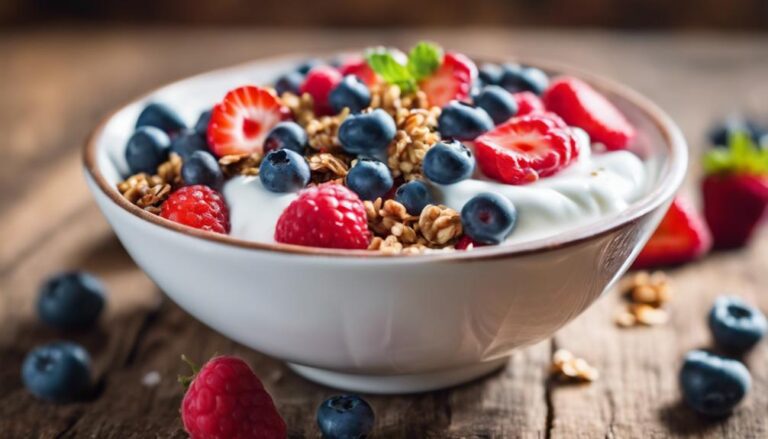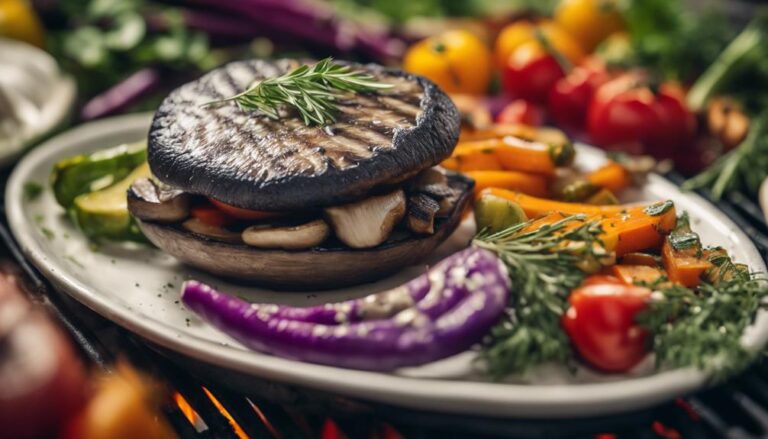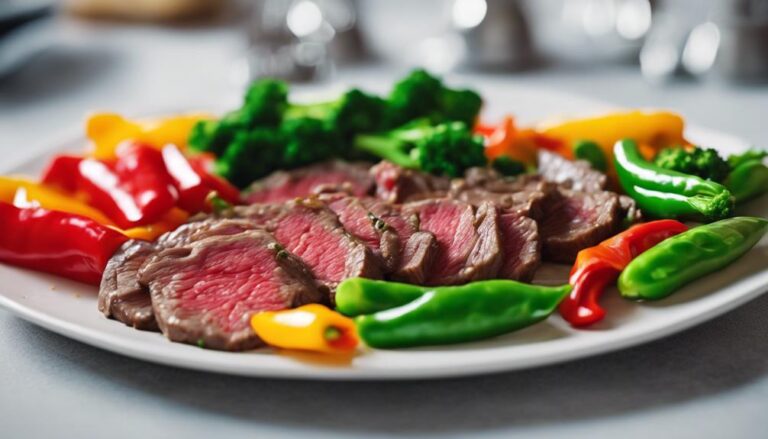Soup Sous Vide Chicken and Vegetable Soup for the MyPlate Diet
Create a nutritious sous vide chicken and vegetable soup for the MyPlate diet. This innovative dish combines tender chicken and colorful veggies, perfect for a balanced meal. Using sous vide guarantees juicy chicken and preserved nutrients. The MyPlate diet emphasizes a variety of food groups, making this soup an ideal choice. By blending modern techniques with quality ingredients, you're on track for a healthy and delicious meal. Explore the benefits of this flavorful soup tailored to your dietary needs.
What You Will Learn Here
- Incorporate lean proteins like sous vide chicken for a balanced MyPlate diet.
- Utilize a variety of colorful vegetables for essential nutrients and MyPlate compliance.
- Sous vide method preserves nutrients and enhances flavor for a healthy soup.
- Balance the soup with grains or legumes for a complete MyPlate meal.
- Customize with herbs and spices to elevate flavors while adhering to MyPlate guidelines.
Soup's Evolution Over Time

Soup has a rich history that dates back centuries, evolving from simple broths to complex culinary creations.
Modern trends have seen soups become more diverse, incorporating global flavors and innovative cooking techniques.
Beyond its delicious taste, soup also offers numerous health benefits, making it a versatile and nutritious meal option for many.
Historical Soup Origins
Over centuries, various cultures around the world have contributed to the evolution of soups, shaping the diverse range of flavors and ingredients we enjoy today. Soup origins trace back to ancient civilizations such as the Greeks and Romans, who used soups as a way to make use of leftover ingredients.
As trade routes expanded, cultural influences from Asia, Africa, and the Americas introduced new spices, vegetables, and cooking techniques to soup-making.
The evolution of soups was greatly impacted by culinary techniques. In the Middle Ages, European chefs began thickening soups with breadcrumbs and roux, while in Asia, the use of miso and soy sauce added rich umami flavors to broths. During the Renaissance, French chefs refined soup-making with the development of consommés and bisques, elevating soups to gourmet status.
Through these cultural influences and culinary innovations, the humble soup transformed into a versatile dish enjoyed worldwide, reflecting the diverse traditions and flavors of different regions.
Modern Soup Trends
As culinary preferences have evolved, modern soup trends reflect a fusion of traditional flavors with contemporary twists, showcasing a dynamic evolution in soup-making techniques and ingredients.
Soup fusion has become increasingly popular, blending diverse culinary techniques from around the world to create innovative flavor profiles. Chefs are experimenting with unique combinations of ingredients, introducing new elements like exotic spices, artisanal broths, and unconventional toppings.
Culinary techniques have also advanced, with chefs incorporating modern cooking methods such as sous vide and molecular gastronomy to elevate soup preparation to new heights. These innovative approaches not only enhance the texture and taste of soups but also provide opportunities for creative presentation and customization.
Moreover, the emphasis on health and wellness has influenced modern soup trends, leading to the incorporation of superfoods, plant-based alternatives, and low-sodium options. By embracing a balance of tradition and innovation, contemporary soups have evolved into a diverse and exciting culinary landscape, offering something for every palate.
Soup's Health Benefits
Throughout history, the evolution of soup has been marked by a gradual transformation towards healthier ingredients and preparation methods. Soups have evolved to offer a wide range of nutritional benefits, incorporating diverse flavor profiles while boosting immune properties and assisting in weight management.
The shift towards incorporating nutrient-dense ingredients such as vegetables, lean proteins, and whole grains has enhanced the nutritional value of soups. These ingredients provide essential vitamins, minerals, and antioxidants that support overall health and well-being.
Additionally, the flavorful combinations of herbs and spices not only enhance taste but also contribute to the immune-boosting properties of soups.
Furthermore, soups can be a helpful addition to a weight management plan due to their high water content and filling nature, which can help control appetite and reduce overall calorie intake.
Key Soup Components
For a flavorful and wholesome soup, focus on selecting high-quality ingredients that will enhance the overall taste and texture of your dish. When it comes to soup components, paying attention to the following key elements will help you craft a delicious and satisfying meal:
- Protein: Choose lean proteins like chicken or tofu to add a hearty and nutritious element to your soup.
- Vegetables: Incorporate a variety of colorful vegetables such as carrots, celery, and bell peppers to provide essential vitamins and minerals.
- Broth: Opt for a flavorful broth, whether it's chicken, vegetable, or beef, to serve as the base of your soup and infuse it with rich taste.
- Herbs and Spices: Experiment with herbs like thyme, rosemary, or spices such as cumin and paprika to elevate the flavor profiles of your soup.
- Grains: Consider adding grains like barley, quinoa, or rice to make your soup more filling and wholesome.
Top Soup Recipes
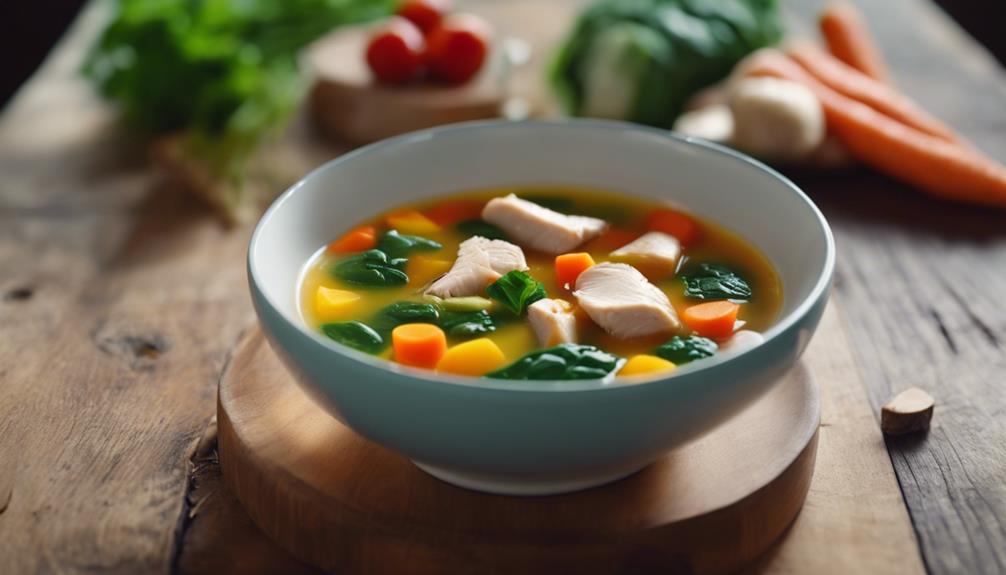
Looking for some top soup recipes to try out?
Consider making Sous Vide Chicken Soup for a flavorful twist on a classic favorite.
If you prefer a meatless option, give Vegetarian Lentil Soup a go for a hearty and nutritious meal.
For a comforting and filling choice, whip up a batch of Hearty Beef Barley Soup that will surely warm you up on a chilly day.
Sous Vide Chicken Soup
To create a flavorful and tender chicken soup using the sous vide method, start by preparing your ingredients and seasoning the chicken breasts. This cooking technique allows for a precise flavor infusion and guarantees that the chicken remains juicy and full of taste.
Here are some benefits of making sous vide chicken soup:
- Enhanced Flavor: The sous vide method locks in the natural juices of the chicken, resulting in a more intense and delicious flavor.
- Tender Texture: Cooking the chicken sous vide guarantees a tender and moist texture, making each bite a delightful experience.
- Convenient Meal Prep: You can pre-season and vacuum-seal the chicken ahead of time, simplifying your meal prep and saving time in the kitchen.
- Consistent Results: Sous vide cooking offers precise temperature control, leading to consistent and perfectly cooked chicken every time.
- Nutrient Retention: By cooking the chicken in a sealed bag, the nutrients are preserved, ensuring a healthy and nourishing soup.
Try this sous vide chicken soup recipe for a delicious and hassle-free meal that will satisfy your taste buds and keep you fueled throughout the day.
Vegetarian Lentil Soup
Explore the rich and hearty flavors of Vegetarian Lentil Soup, a top soup recipe that offers a nutritious and satisfying meal option perfect for any occasion. If you're looking for delicious vegetarian options packed with protein sources, this soup is a fantastic choice.
Here are some reasons why Vegetarian Lentil Soup should be on your menu:
- Rich in Plant-Based Proteins: Lentils are a great source of protein for vegetarians, helping to meet your daily protein needs.
- High in Fiber: This soup is loaded with fiber, aiding digestion and keeping you feeling full and satisfied.
- Packed with Vitamins and Minerals: Lentils are rich in essential nutrients like iron, folate, and potassium, promoting overall health.
- Low in Fat: Enjoy a comforting bowl of soup without worrying about excessive fat content.
- Versatile and Flavorful: Add your favorite herbs and spices to customize the taste and make it uniquely yours.
Try this Vegetarian Lentil Soup for a wholesome and protein-packed meal that's both nutritious and delicious!
Hearty Beef Barley Soup
Discover the savory satisfaction of Hearty Beef Barley Soup, a top soup recipe that promises a comforting and flavorful dining experience. This classic soup combines tender beef chunks, wholesome barley, and rich beef broth to create a hearty dish perfect for any time of the year.
Whether made from scratch with homemade beef broth or prepared quickly using canned options, this soup is sure to warm your soul and satisfy your hunger.
Here are five key points to ponder when making Hearty Beef Barley Soup:
- Utilize high-quality beef broth to enhance the depth of flavor.
- Experiment with different soup varieties by adding vegetables like carrots, celery, and peas.
- Opt for homemade beef broth for a more personalized touch, or choose convenient canned options for a quicker meal.
- Adjust the barley-to-broth ratio to achieve your preferred soup consistency.
- Allow the soup to simmer slowly to let the flavors meld together for the best taste experience.
Sous Vide Temperature Recommendations
When cooking sous vide, it's important to pay attention to ideal cooking temperatures.
Having the right sous vide equipment is essential for precision in your cooking.
Always remember to follow safety precautions to guarantee a safe and delicious meal.
Optimal Cooking Temperatures
For the best results when cooking sous vide, it's essential to adhere to specific temperature recommendations for different types of ingredients. Sous vide cooking techniques rely on precise temperature control to guarantee food safety and achieve ideal results.
When cooking chicken sous vide, it's recommended to set the water bath temperature between 140°F to 165°F to make sure the chicken reaches a safe internal temperature while remaining tender and juicy.
Vegetables, on the other hand, often require temperatures ranging from 183°F to 190°F to break down tough fibers and enhance flavors without becoming mushy.
Maintaining these ideal cooking temperatures is crucial to ensure that your sous vide dishes aren't only safe to consume but also delicious. Temperature control in sous vide cooking is essential for pasteurization, ensuring harmful bacteria are eliminated while preserving the integrity of the ingredients.
Sous Vide Equipment Needed
Consider the essential equipment needed for successful sous vide cooking, including a precision cooker and a vacuum sealer for best results. Sous vide equipment plays a crucial role in achieving precise temperatures and consistent cooking outcomes.
The precision cooker regulates the water temperature with accuracy, ensuring your ingredients are cooked evenly throughout. This device is fundamental for the sous vide method, allowing you to set specific temperatures for perfect doneness.
Additionally, a vacuum sealer is necessary for securely packaging your food items before immersing them in the water bath. By removing air and sealing the ingredients in a vacuum-sealed bag, you enhance flavor infusion and prevent moisture loss during the cooking process.
These cooking techniques, coupled with the right equipment, enable you to achieve restaurant-quality results in the comfort of your own kitchen. Invest in quality sous vide equipment to elevate your culinary skills and enjoy delicious meals with precision and consistency.
Safety Precautions to Consider
To guarantee food safety and best cooking results, it's important to be mindful of the recommended sous vide temperature guidelines. Proper food handling is essential when preparing sous vide dishes. Make sure that ingredients are sourced from reputable sources and stored correctly before cooking. Throughout the cooking process, monitor the temperature carefully to prevent any risks of bacterial contamination.
When sous vide cooking, it's essential to follow the recommended temperature ranges for different types of food to ensure they're cooked thoroughly and safely. Proper storage of ingredients both before and after cooking is critical to maintain food quality and prevent spoilage.
Final Thoughts
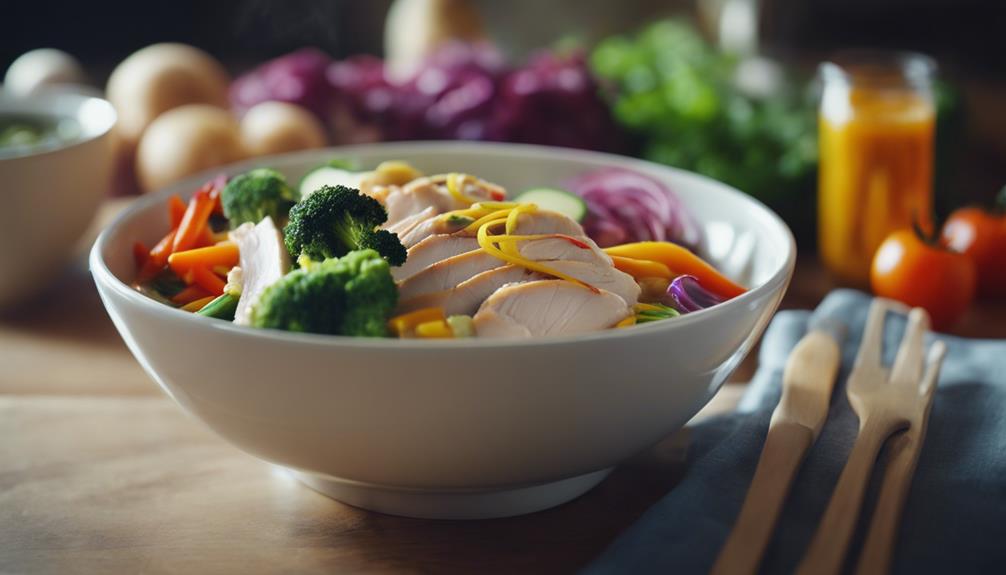
As you reflect on the flavors and textures of this sous vide chicken and vegetable soup, consider how the gentle cooking method has improved the overall taste and tenderness of the ingredients. The sous vide benefits are evident in the way the flavors are sealed in, creating a rich and savory broth that perfectly complements the tender chicken and vibrant vegetables. This cooking technique guarantees that every bite is infused with the essence of the ingredients, resulting in a soup that's both satisfying and delicious.
In terms of MyPlate effectiveness, this soup checks off all the boxes for a well-balanced meal. Packed with protein from the chicken, a variety of vegetables for vitamins and minerals, and a flavorful broth that keeps you coming back for more, it's a wholesome and nutritious option.
The satisfaction of enjoying a warm bowl of soup that not only tastes great but also nourishes your body is unmatched. So next time you're looking for a satisfying and flavorful meal that aligns with the MyPlate guidelines, consider whipping up a batch of sous vide chicken and vegetable soup.
Frequently Asked Questions
Can I Freeze the Sous Vide Chicken and Vegetable Soup?
Yes, you can freeze soup to extend its shelf life. Properly stored, frozen soup can maintain flavor and quality for several months. Be sure to use airtight containers or freezer bags to prevent freezer burn.
Are There Any Alternative Vegetables I Can Use in the Soup?
You can easily substitute vegetables in the soup for variety. Get creative with flavor customization by trying alternatives like zucchini, bell peppers, or spinach. Experiment with different options to suit your taste preferences.
How Can I Adjust the Seasoning to Suit My Taste Preferences?
To adjust the seasoning to suit your taste preferences, start by experimenting with different herbs and spices. Personalize the seasoning by adding a little at a time, tasting along the way until it's just right for you.
Can I Use Boneless Chicken for This Recipe?
Yes, you can use boneless chicken for the recipe. When cooking sous vide, boneless cuts work well. Adjust cooking times accordingly. For dietary restrictions, make sure the chicken is lean and fits your dietary needs.
Is It Safe to Leave the Soup Cooking in the Sous Vide for Longer Than Recommended?
Leaving soup cooking in the sous vide for longer than recommended can pose safety risks. Extended cooking times may lead to bacterial growth and compromised food safety. It's best to follow the suggested cooking times for best results.
Conclusion
To sum up, sous vide cooking provides a precise and consistent method for creating delicious chicken and vegetable soup that aligns with the MyPlate diet guidelines. By carefully controlling the temperature and cooking time, you can guarantee that your soup retains maximum flavor and nutrients.
Experiment with different ingredients and seasoning to customize your soup to your preferences while still following a balanced and healthy diet. Enjoy the process of creating a comforting and nutritious meal with sous vide cooking techniques.
